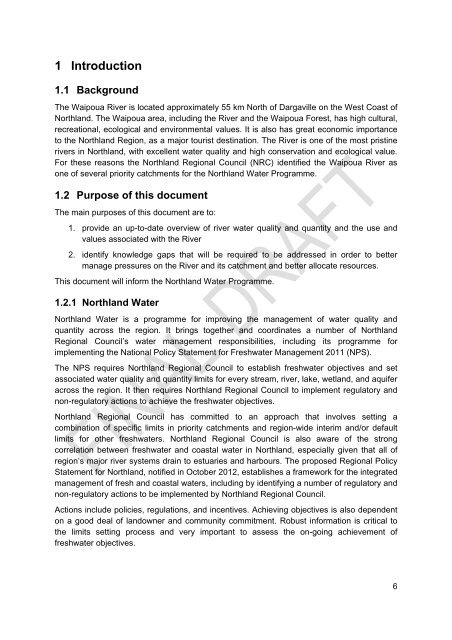Waipoua River 20130219.pdf - Northland Regional Council
Waipoua River 20130219.pdf - Northland Regional Council
Waipoua River 20130219.pdf - Northland Regional Council
- No tags were found...
Create successful ePaper yourself
Turn your PDF publications into a flip-book with our unique Google optimized e-Paper software.
1 Introduction1.1 BackgroundThe <strong>Waipoua</strong> <strong>River</strong> is located approximately 55 km North of Dargaville on the West Coast of<strong>Northland</strong>. The <strong>Waipoua</strong> area, including the <strong>River</strong> and the <strong>Waipoua</strong> Forest, has high cultural,recreational, ecological and environmental values. It is also has great economic importanceto the <strong>Northland</strong> Region, as a major tourist destination. The <strong>River</strong> is one of the most pristinerivers in <strong>Northland</strong>, with excellent water quality and high conservation and ecological value.For these reasons the <strong>Northland</strong> <strong>Regional</strong> <strong>Council</strong> (NRC) identified the <strong>Waipoua</strong> <strong>River</strong> asone of several priority catchments for the <strong>Northland</strong> Water Programme.1.2 Purpose of this documentThe main purposes of this document are to:1. provide an up-to-date overview of river water quality and quantity and the use andvalues associated with the <strong>River</strong>2. identify knowledge gaps that will be required to be addressed in order to bettermanage pressures on the <strong>River</strong> and its catchment and better allocate resources.This document will inform the <strong>Northland</strong> Water Programme.1.2.1 <strong>Northland</strong> Water<strong>Northland</strong> Water is a programme for improving the management of water quality andquantity across the region. It brings together and coordinates a number of <strong>Northland</strong><strong>Regional</strong> <strong>Council</strong>’s water management responsibilities, including its programme forimplementing the National Policy Statement for Freshwater Management 2011 (NPS).The NPS requires <strong>Northland</strong> <strong>Regional</strong> <strong>Council</strong> to establish freshwater objectives and setassociated water quality and quantity limits for every stream, river, lake, wetland, and aquiferacross the region. It then requires <strong>Northland</strong> <strong>Regional</strong> <strong>Council</strong> to implement regulatory andnon-regulatory actions to achieve the freshwater objectives.<strong>Northland</strong> <strong>Regional</strong> <strong>Council</strong> has committed to an approach that involves setting acombination of specific limits in priority catchments and region-wide interim and/or defaultlimits for other freshwaters. <strong>Northland</strong> <strong>Regional</strong> <strong>Council</strong> is also aware of the strongcorrelation between freshwater and coastal water in <strong>Northland</strong>, especially given that all ofregion’s major river systems drain to estuaries and harbours. The proposed <strong>Regional</strong> PolicyStatement for <strong>Northland</strong>, notified in October 2012, establishes a framework for the integratedmanagement of fresh and coastal waters, including by identifying a number of regulatory andnon-regulatory actions to be implemented by <strong>Northland</strong> <strong>Regional</strong> <strong>Council</strong>.Actions include policies, regulations, and incentives. Achieving objectives is also dependenton a good deal of landowner and community commitment. Robust information is critical tothe limits setting process and very important to assess the on-going achievement offreshwater objectives.6
















